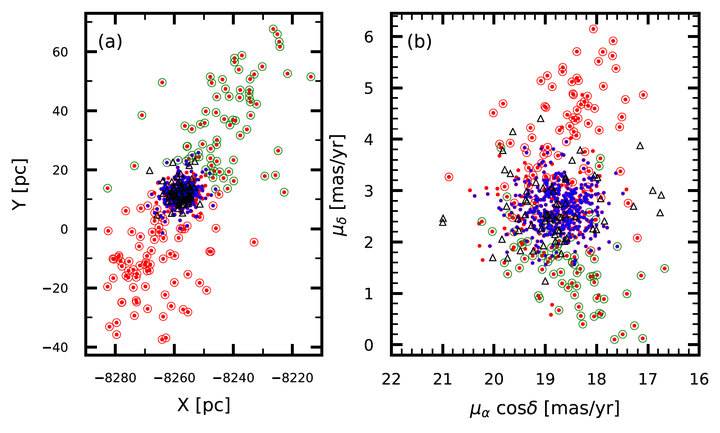Diagnosing the Stellar Population and Tidal Structure of the Blanco1 Star Cluster
 Image credit: Figure 4 in Zhang et al. 2020. (a) Top view of Blanco1; (b) PM plot
Image credit: Figure 4 in Zhang et al. 2020. (a) Top view of Blanco1; (b) PM plot
Abstract
We present the stellar population, using Gaia/DR2 parallax, kinematics, and photometry, of the young ($\sim 100$Myr), nearby ($\sim 230$pc) open cluster, Blanco1. A total of 644 member candidates are identified via the unsupervised machine learning method StarGO to find the clustering in the 5-dimensional position and proper motion parameter ($X$, $Y$, $Z$, $\mu_\alpha \cos\delta$, $\mu_\delta$) space. Within the tidal radius of $10.0 \pm 0.3$pc, there are 488 member candidates, 3 times more than those outside. Seen toward the Galactic South Pole, Blanco,1 renders a vintage view of its morphology in the Galactic plane. A leading tail and a trailing tail, each of 50–60pc, are found for the first time for this cluster, with stars further from the cluster center streaming away faster, manifest stellar stripping. Blanco1 has a total detected mass of $285\pm32$ M${\odot}$ with a mass function consistent with a slope of $\alpha=1.35\pm0.2$ in the sense of $dN/dm \propto m^{-\alpha}$, in the mass range of $0.25$–$2.51$ M${\odot}$, where $N$ is the number of members and $m$ is stellar mass. A Minimum Spanning Tree ($\Lambda_{\rm MSR}$) analysis shows the cluster to be moderately mass segregated among the most massive members ($\gtrsim 1.4$ M$_{\odot}$), suggesting an early stage of dynamical disintegration.